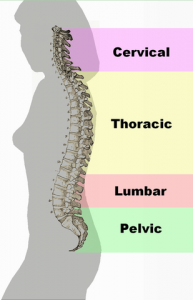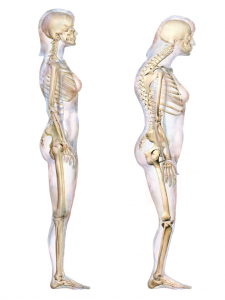What Is “Kyphosis”?
The spine is separated into three different regions – cervical, thoracic, and lumbar. Each region has it’s own natural curve. Kyphosis occurs naturally in the middle portion of the spine – the thoracic – and includes your ribs and chest plate.
What Can I do About My Hyperkyphosis?
Age-related hyperkyphosis is an exaggerated hunch in the thoracic spine that occurs commonly with advanced age. This causes your head to be set more forward from your shoulders. This condition is associated with other issues such as low bone mass, vertebral compression fractures, and degenerative disc disease. If hyperkyphosis is not treated, people can have difficulty performing normal tasks such as bathing, getting out of a chair, bending, or walking. There are effective treatments including physical therapy, pain medication, exercise, and surgery. However, there are no public health approaches to prevent hyperkyphosis among older adults. Until Now!
A hunchback posture impairs:
- Healthy Movement
- Interferes with the ability to stand erect and maintain normal spinal alignment
- Worsens problems with vision, neck stiffness, and shoulder function
2. Increases the risk of falls due to:
- Significantly poorer balance
- Slower walking speed
- Decreased stair-climbing speed
3. Increases fracture risk:
- Older women with hyperkyphosis have a 70% increased risk of future fracture, independent of age or prior fracture.
- The risk for fracture increases as hyperkyphosis progresses.
Preventing The Hunchback Posture
Recognition and treatment of hyperkyphosis could contribute to reduced risk of falls, fractures, and functional limitations. A trained physical therapist has the tools to evaluate your hyperkyphosis. Following the evaluation the physical therapist will implement a treatment or preventative strategy unique to your needs. Here are a few corrective videos to get you started.
All 4’s Mid-Back Stretch
Door Stretch
Active Hip Extension
Citation:
Ferrucci L, Bandinelli S, Cavazzini C, et al. Neurological examination findings to predict limitations in mobility and falls in older persons without a history of neurological disease. Am J Med. 2004;116:807-815.
Huang MH, Barrett-Connor E, Greendale GA, Kado DM. Hyperkyphotic posture and risk of future osteoporotic fractures: the Rancho Bernardo study. J Bone Miner Res. 2006;21:419-423. http://dx.doi.org/10.1359/JBMR.051201
Kado DM, Huang MH, Nguyen CB, Barrett-Connor E, Greendale GA. Hyperkyphotic posture and risk of injurious falls in older persons: the Rancho Bernardo Study. J Gerontol A Biol Sci Med Sci. 2007;62:652-657.
The information provided on this site is intended for your general knowledge only and is not a substitute for professional medical advice or treatment for specific medical conditions. You should not use this information to diagnose or treat a health problem or disease without consulting with Heather Lane Physical Therapy or another qualified healthcare provider.




Thanks, it’s very informative